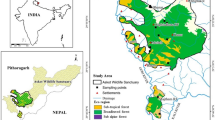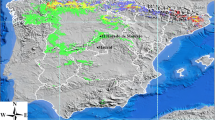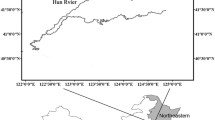Abstract
Under climate change, the adoption of historical reference as the objective of forest restoration is being questioned. In this study, the spatially explicit forest landscape model LANDIS was utilized to analyze how the forest landscape in the upper Hun River area of Liaoning province in northeast China would be affected under current climate trends and future climate change; and to explore whether the historical reference should be the objective of restoration efforts. The results showed that (1) the area percentage (AP) of Quercusmongolica under climate change is always higher than that under the current climate regime, while the AP of Pinuskoraiensis is lower than that under current climate; and (2) the competitive ability of Q. mongolica and Populus davidiana increases, while that of other species decreases under climate change. As interspecies competition shifts under climate change, the historical reference appears in appropriate to serve as the objective of forest restoration. In addition, although Q. mongolica would likely benefit from a warmer and drier climate, use of this species for forest restoration under climate change still requires further research.




Similar content being viewed by others
References
Aizawa M, Kim ZS, Yoshimaru H (2012) Phylogeography of the Korean pine (Pinus koraiensis) in northeast Asia: inferences from organelle gene sequences. J Plant Res 125:713–723
Arend M, Brem A, Kuster TM, Gunthardt-Goerg MS (2013) Seasonal photosynthetic responses of European oaks to drought and elevated daytime temperature. Plant Biol 15:169–176
Bannister JR, Coopman RE, Donoso PJ, Bauhus J (2013) The importance of micro topography and nurse canopy for successful restoration planting of the slow-growing conifer Pilgerodendron uviferum. Forests 4:85–103
Bolte A, Ammer C, Lof M, Madsen P, Nabuurs G-J, Schall P, Spathelf P, Rock J (2009) Adaptive forest management in central Europe: climate change impacts, strategies and integrative concept. Scand J Forest Res 24:473–482
Bolte A, Hilbrig L, Grundmann B, Kampf F, Brunet J, Roloff A (2010) Climate change impacts on stand structure and competitive interactions in a southern Swedish spruce-beech forest. Eur J Forest Res 129:261–276
Brancalion PHS, Viani RAG, Aronson J, Rodrigues RR, Nave AG (2012) Improving planting stocks for the Brazilian Atlantic forest restoration through community-based seed harvesting strategies. Restor Ecol 20:704–711
Brown ER, Johnson PA (1998) The need for clearly defined objectives in stream restoration design
Bu R, He HS, Hu YM, Chang Y, Larsen DR (2008) Using the LANDIS model to evaluate forest harvesting and planting strategies under possible warming climates in Northeastern China. For Ecol Manage 254:407–419
Bugmann HKM, Yan XD, Sykes MT, Martin P, Lindner M, Desanker PV, Cumming SG (1996) A comparison of forest gap models: model structure and behaviour. Clim Change 34:289–313
Chang Y, He HS, Bishop I, Hu YM, Bu RC, Xu CG, Li XZ (2007) Long-term forest landscape responses to fire exclusion in the Great Xing’an Mountains, China. Int J Wildland Fire 16:34–44
Chen X, Li B-L, Lin Z-S (2003) The acceleration of succession for the restoration of the mixed-broadleaved Korean pine forests in Northeast China. For Ecol Manage 177:503–514
Chrysopolitou V, Apostolakis A, Avtzis D, Avtzis N, Diamandis S, Kemitzoglou D, Papadimos D, Perlerou C, Tsiaoussi V, Dafis S (2013) Studies on forest health and vegetation changes in Greece under the effects of climate changes. Biodivers Conserv 22:1133–1150
Craven D, Hall JS, Ashton MS, Berlyn GP (2013) Water-use efficiency and whole-plant performance of nine tropical tree species at two sites with contrasting water availability in Panama. Trees-struct Funct 27:639–653
Critchley CNR, Wilson LA, Mole AC, Norton LR, Smart SM (2013) A functional classification of herbaceous hedgerow vegetation for setting restoration objectives. Biodivers Conserv 22:701–717
DeLonge M, D’Odorico P, Lawrence D (2008) Feedbacks between phosphorus deposition and canopy cover: the emergence of multiple stable states in tropical dry forests. Glob Change Biol 14:154–160
Dobson AP, Bradshaw AD, Baker AJM (1997) Hopes for the future: restoration ecology and conservation biology. Science 277:515–522
Dukes JS, Mooney HA (1999) Does global change increase the success of biological invaders? Trends Ecol Evol 14:135–139
Falk D, Palmer M, Zedler JB (2006) Foundations of restoration ecology. Island Press, Washington
Fu J (2009) Current situation of Natural Korean P i ne Forests in N or theast China and their management counter measures. Journal of Northeast Forestry University, pp 75–78
Gebrekirstos A, van Noordwijk M, Neufeldt H, Mitlohner R (2011) Relationships of stable carbon isotopes, plant water potential and growth: an approach to asses water use efficiency and growth strategies of dry land agroforestry species. Trees-struct Funct 25:95–102
Gillson L, Willis KJ (2004) ‘As Earth’s testimonies tell’: wilderness conservation in a changing world. Ecol Lett 7:990–998
Godefroid S, Monbaliu D, Massant W, Van Der Aa B, De Vos B, Quivy V, Koedam N (2007) Effects of soil mechanical treatments combined with bramble and bracken control on the restoration of degraded understory in an ancient beech forest. Ann Forest Sci 64:321–331
Gonzalez E, Comin FA, Muller E (2010) Seed dispersal, germination and early seedling establishment of Populus alba L. under simulated water table declines in different substrates. Trees-struct Funct 24:151–163
Griscom HP, Ashton MS (2011) Restoration of dry tropical forests in Central America: a review of pattern and process. For Ecol Manage 261:1564–1579
Hanberry BB, Kabrick JM, He HS, Palik BJ (2012) Historical trajectories and restoration strategies for the Mississippi River Alluvial Valley. For Ecol Manage 280:103–111
Harris JA, Hobbs RJ, Higgs E, Aronson J (2006) Ecological restoration and global climate change. Restor Ecol 14:170–176
He HS, Mladenoff DJ (1999a) The effects of seed dispersal on the simulation of long-term forest landscape change. Ecosystems 2:308–319
He HS, Mladenoff DJ (1999b) Spatially explicit and stochastic simulation of forest-landscape fire disturbance and succession. Ecology 80:81–99
He HS, Mladenoff DJ, Crow TR (1999) Linking an ecosystem model and a landscape model to study forest species response to climate warming. Ecol Modell 114:213–233
He HS, Hao ZQ, Larsen DR, Dai LM, Hu YM, Chang Y (2002) A simulation study of landscape scale forest succession in northeastern China. Ecol Modell 156:153–166
He HS, Hao ZQ, Mladenoff DJ, Shao GF, Hu YM, Chang Y (2005) Simulating forest ecosystem response to climate warming incorporating spatial effects in north-eastern China. J Biogeogr 32:2043–2056
Heikkila M, Fontana SL, Seppa H (2009) Rapid Lateglacial tree population dynamics and ecosystem changes in the eastern Baltic region. J Quat Sci 24:802–815
Hohensinner S, Haidvogl G, Jungwirth M, Muhar S, Preis S, Schmutz S (2005) Historical analysis of habitat turnover and age distributions as a reference for restoration of Austrian Danube floodplains. In, River Basin Management III, pp. 489–502
Holl KD (2011) Regreening the Bare hills: tropical forest restoration in the Asia-Pacific region. Human Ecol 39:841–842
Huang L, Shao QQ, Liu JY (2012) Forest restoration to achieve both ecological and economic progress, Poyang Lake basin, China. Ecol Eng 44:53–60
Hulme PE (2005) Adapting to climate change: is there scope for ecological management in the face of a global threat? J Appl Ecol 42:784–794
Imbert E, Lefevre F (2003) Dispersal and gene flow of Populus nigra (Salicaceae) along a dynamic river system. J Ecol 91:447–456
Jasinski JPP, Payette S (2005) The creation of alternative stable states in the southern boreal forest, Quebec, Canada. Ecol Monogr 75:561–583
Johnston CA, Zedler JB (2012) Identifying Preferential Associates to Initiate Restoration Plantings. Restor Ecol 20:764–772
Katona K, Kiss M, Bleier N, Szekely J, Nyeste M, Kovacs V, Terhes A, Fodor A, Olajos T, Rasztovits E, Szemethy S (2013) Ungulate browsing shapes climate change impacts on forest biodiversity in Hungary. Biodivers Conserv 22:1167–1180
Kirschbaum MUF (2000) Forest growth and species distribution in a changing climate. Tree Physiol 20:309–322
Lamb D (1998) Large-scale ecological restoration of degraded tropical forest lands: the potential role of timber plantations. Restor Ecol 6:271–279
Lee KM, Kim YY, Hyun JO (2011) Genetic variation in populations of Populus davidiana Dode based on microsatellite marker analysis. Genes Genomics 33:163–171
Leng WF, He HS, Bu RC, Dai LM, Hu YM, Wang XG (2008) Predicting the distributions of suitable habitat for three larch species under climate warming in Northeastern China. For Ecol Manage 254:420–428
Li J, Nie S, An B (2005) Stump sprouting of the main broad-leaved tree species of secondary forest in Eastern area of Northest China. Scientia Silvae Sinicae 41:72–77
Li HT, Wang XL, Hamann A (2010) Genetic adaptation of aspen (Populus tremuloides) populations to spring risk environments: a novel remote sensing approach. Can J Forest Res 40:2082–2090
Liu N, Guo QF (2012) Resource-use efficiencies of three indigenous tree species planted in resource islands created by shrubs: implications for reforestation of subtropical degraded shrublands. Plant Ecol 213:1177–1185
Liu XZ, Lu YC, Zhou YH, Lei XD, Zhang XQ, Meng JH (2011) The influence of soil conditions on regeneration establishment for degraded secondary forest restoration, Southern China. For Ecol Manage 261:1771–1780
Maloney PE, Vogler DR, Eckert AJ, Jensen CE, Neale DB (2011) Population biology of sugar pine (Pinus lambertiana Dougl.) with reference to historical disturbances in the Lake Tahoe Basin: implications for restoration. For Ecol Manage 262:770–779
Mason NWH, Ausseil AGE, Dymond JR, Overton JM, Price R, Carswell FE (2012) Will use of non-biodiversity objectives to select areas for ecological restoration always compromise biodiversity gains? Biol Conserv 155:157–168
Meli P, Martinez-Ramos M, Rey-Benayas JM (2013) Selecting species for passive and active riparian restoration in southern Mexico. Restor Ecol 21:163–165
Meng JH, Lu YC, Lei XD, Liu G (2011) Structure and floristics of tropical forests and their implications for restoration of degraded forests of China’s Hainan Island. Trop Ecol 52:177–191
Michelot A, Breda N, Damesin C, Dufrene E (2012) Differing growth responses to climatic variations and soil water deficits of Fagus sylvatica, Quercus petraea and Pinus Sylvester’s in a temperate forest. For Ecol Manage 265:161–171
Milad M, Schaich H, Burgi M, Konold W (2011) Climate change and nature conservation in Central European forests: a review of consequences, concepts and challenges. For Ecol Manage 261:829–843
Millar CI (1998) Reconsidering the conservation of Monterey pine. Fremontia 26:12–16
Millar CI, Stephenson NL, Stephens SL (2007) Climate change and forests of the future: managing in the face of uncertainty. Ecol Appl 17:2145–2151
Munro NT, Fischer J, Wood J, Lindenmayer DB (2012) Assessing ecosystem function of restoration plantings in south-eastern Australia. For Ecol Manage 282:36–45
Norton DA (2009) Species invasions and the limits to restoration: learning from the New Zealand experience. Science 325:569–571
Ogden AE, Innes J (2007) Incorporating climate change adaptation considerations into forest management planning in the boreal forest. Int Forest Rev 9:713–733
Parmesan C, Yohe G (2003) A globally coherent fingerprint of climate change impacts across natural systems. Nature 421:37–42
Ponce-Reyes R, Nicholson E, Baxter PWJ, Fuller RA, Possingham H (2013) Extinction risk in cloud forest fragments under climate change and habitat loss. Divers Distrib 19:518–529
Reyer C, Lasch P, Mohren GMJ, Sterck FJ (2010) Inter-specific competition in mixed forests of Douglas-fir (Pseudotsuga menziesii) and common beech (Fagus sylvatica) under climate change: a model-based analysis. Ann Forest Sci 67:805P1–805P11
Rice KJ, Emery NC (2003) Managing microevolution: restoration in the face of global change. Front Ecol Environ 1:469–478
Rigling A, Bigler C, Eilmann B, Feldmeyer-Christe E, Gimmi U, Ginzler C, Graf U, Mayer P, Vacchiano G, Weber P, Wohlgemuth T, Zweifel R, Dobbertin M (2013) Driving factors of a vegetation shift from Scots pine to pubescent oak in dry Alpine forests. Glob Change Biol 19:229–240
Rodrigues RR, Lima RAF, Gandolfi S, Nave AG (2009) On the restoration of high diversity forests: 30 years of experience in the Brazilian Atlantic Forest. Biol Conserv 142:1242–1251
Rodrigues RR, Gandolfi S, Nave AG, Aronson J, Barreto TE, Vidal CY, Brancalion PHS (2011) Large-scale ecological restoration of high-diversity tropical forests in SE Brazil. For Ecol Manage 261:1605–1613
Saxe H, Kerstiens G (2005) Climate change reverses the competitive balance of ash and beech seedlings under simulated forest conditions. Plant Biol 7:375–386
Schumacher S, Bugmann H, Mladenoff DJ (2004) Improving the formulation of tree growth and succession in a spatially explicit landscape model. Ecol Modell 180:175–194
Schumacher S, Reineking B, Sibold J, Bugmann H (2006) Modeling the impact of climate and vegetation on fire regimes in mountain landscapes. Landsc Ecol 21:539–554
Shao G (2003) Sensitivities of species compositions of the mixed forest in eastern Eurasian continent to climate change. Global Planet Change 37:307–313
Shinneman DJ, Cornett MW, Palik BJ (2010) Simulating restoration strategies for a southern boreal forest landscape with complex land ownership patterns. For Ecol Manage 259:446–458
Shinneman DJ, Palik BJ, Cornett MW (2012) Can landscape-level ecological restoration influence fire risk? A spatially-explicit assessment of a northern temperate-southern boreal forest landscape. For Ecol Manage 274:126–135
Singh K, Singh B, Singh RR (2012) Changes in physico-chemical, microbial and enzymatic activities during restoration of degraded sodic land: ecological suitability of mixed forest over monoculture plantation. CATENA 96:57–67
Stromayer KAK, Warren RJ (1997) Are overabundant deer herds in the eastern United States creating alternate stable states in forest plant communities? Wildlife Soc B 25:227–234
Trueman M, Hobbs RJ, Van Niel K (2013) Interdisciplinary historical vegetation mapping for ecological restoration in Galapagos. Landsc Ecol 28:519–532
Van Andel J, Aronson J (2006) Restoration ecology: the new frontier. Blackwell, Oxford
Wang XG, He HS, Li XZ, Chang Y, Hu YM, Xu CG, Bu RC, Xie FJ (2006) Simulating the effects of reforestation on a large catastrophic fire burned landscape in Northeastern China. For Ecol Manage 225:82–93
Wang H, Shao XM, Jiang Y, Fang XQ, Wu SH (2013) The impacts of climate change on the radial growth of Pinus koraiensis along elevations of Changbai Mountain in northeastern China. For Ecol Manage 289:333–340
Woelfle-Erskine C, Wilcox AC, Moore JN (2012) Combining historical and process perspectives to infer ranges of geomorphic variability and inform river restoration in a wandering gravel-bed river. Earth Surf Proc Land 37:1302–1312
Wyckoff PH, Bowers R (2010) Response of the prairie-forest border to climate change: impacts of increasing drought may be mitigated by increasing CO2. J Ecol 98:197–208
Xu CG, Gertner GZ, Scheller RM (2012) Importance of colonization and competition in forest landscape response to global climatic change. Clim Change 110:53–83
Yan CF, Han SJ, Zhou YM, Zheng XB, Yu DD, Zheng JQ, Dai GH, Li MH (2013) Needle delta C-13 and mobile carbohydrates in Pinus koraiensis in relation to decreased temperature and increased moisture along an elevational gradient in NE China. Trees-struct Funct 27:389–399
Yao J, He X, Wang A, Chen W, Li X, Lewis BJ, Lv X (2012) Influence of forest management regimes on forest dynamics in the upstream region of the hun river in northeastern China. Plos One 7:e39058
Yu M, Gao QO (2011) Leaf-traits and growth allometry explain competition and differences in response to climatic change in a temperate forest landscape: a simulation study. Ann Bot-london 108:885–894
Yu DY, Shi PJ, Han GY, Zhu WQ, Du SQ, Xun B (2011) Forest ecosystem restoration due to a national conservation plan in China. Ecol Eng 37:1387–1397
Zhang XL, Zang RG, Li CY (2004) Population differences in physiological and morphological adaptations of Populus davidiana seedlings in response to progressive drought stress. Plant Sci 166:791–797
Zhang X, Wu N, Li C (2005) Physiological and growth responses of Populus davidiana ecotypes to different soil water contents. J Arid Environ 60:567–579
Zhang J, Hao Z, Song B, Ye J, Li B, Yao X (2007) Spatial distribution patterns and associations of Pinus koraiensis and Tilia amurensis in broad-leaved Korean pine mixed forest in Changbai Mountains. Chin J Appl Ecol 18:1681–1687
Zhang XH, Huang QL, Zhang C (2010) Analysis of forest landscape dynamics based on forest landscape restoration: a case study of Yong’an city, Fujian province, China. Eur J Forest Res 129:975–980
Zhang M, Zhu J, Yan Q (2012) Seed germination of Pinus koraiensis Siebold & Zucc in response to light regimes caused by shading and seed positions. For Syst 21:426–438
Zhou YM, Schaub M, Shi LX, Guo ZL, Fan AA, Yan CF, Wang XJ, Wang CG, Han SJ, Li MH (2012) Non-linear response of stomata in Pinus koraiensis to tree age and elevation. Trees-struct Funct 26:1389–1396
Zhu J-J, Liu Z-G, Wang H-X (2008) Obstacles for natural regeneration of Larix olgensis plantations in montane regions of eastern Liaoning province. China, Chin J Appl Ecol 19
Acknowledgments
Funding for this study was provided by the National Science & Technology Major Project of China (No. 2012ZX07202-008), and the National Science & Technology Pillar Program of China (No. 2012BAC05B00).
Author information
Authors and Affiliations
Corresponding author
Appendix
Appendix
See Table 2.
Rights and permissions
About this article
Cite this article
Yao, J., He, X., He, H. et al. Should we respect the historical reference as basis for the objective of forest restoration? A case study from Northeastern China. New Forests 45, 671–686 (2014). https://doi.org/10.1007/s11056-014-9430-z
Received:
Accepted:
Published:
Issue Date:
DOI: https://doi.org/10.1007/s11056-014-9430-z




